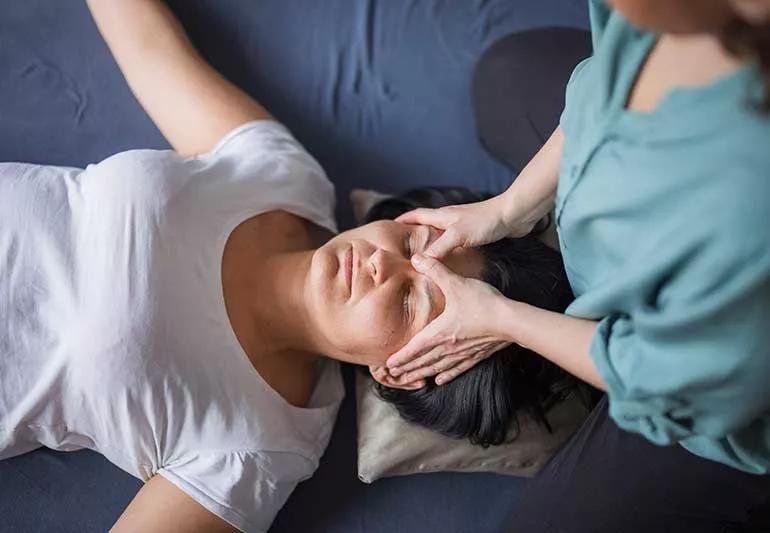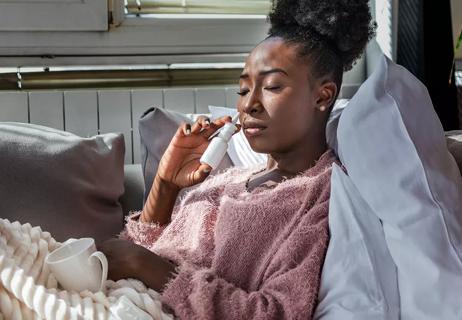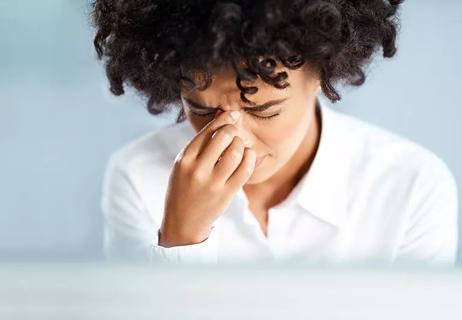A gentle touch in all the right places may help drain your sinuses

If you’re prone to sinus congestion, you know the feeling all too well. Puffy eyes. Stuffed up nose. Pressure that makes your whole face hurt.
Advertisement
Cleveland Clinic is a non-profit academic medical center. Advertising on our site helps support our mission. We do not endorse non-Cleveland Clinic products or services. Policy
Maybe it’s allergies. Or a cold. Or the phase of the moon. Or whatever. No matter the reason, you probably want to be rid of that sinus pressure. Fast.
You know that things like neti pots, antihistamines, warm compresses and sleeping with a humidifier can help. A cool washcloth or refrigerated ice pack might do the trick, too. And if it’s a bacterial sinus infection, a round of antibiotics may be needed.
But here’s one you might not have tried: Sinus massage.
Now before your imagination runs wild — no, we’re not talking about massaging the inside of your sinuses (no instruments up the nose here). Rather, we’re talking about applying some light pressure to certain regions of your face to help promote drainage.
“Inflammation in your sinuses leads to a buildup of fluid that causes puffiness and pressure,” explains massage therapist Vickie Bodner, LMT. “Some targeted massage techniques may help to relieve some of that congestion and promote fluid drainage.”
Bodner walks us through a step-by-step sinus self-massage that may help you breathe a little easier.
Your sinuses are the four hollow spaces in each side of your head and face that allow air and mucus to flow. They’re connected by narrow passageways. When all is well, air and mucus make their way through your sinuses and out of your nose without you ever really even thinking about it.
Advertisement
But when your sinuses become inflamed, those passages narrow. That gums up the works. Mucus gets trapped and it becomes a chore to breathe out of your nose. The result? A pile of used tissues filling up your trash can and aches in your face and behind your eyes.
Sound familiar?
Although there aren’t any research studies to support this practice, in Bodner’s experience, massage may help to get things flowing again.
You have four sinus cavities each side in your face. The two largest are the frontal and maxillary sinuses.
Your frontal sinuses are located in the bottom part of your forehead. They’re right around the innermost parts of each of your eyebrows.
Your maxillary sinuses are just under your eyes, behind your cheekbones on each side of your face.
“To get sinus relief from massage, you’ll want to target any areas where you feel sinus discomfort — whether in your forehead, cheeks or both,” Bodner says. “Remember, though, that you’ll want to use a very light touch with any sinus massage. You don’t want to add extra pressure to those inflamed sinus cavities.”
Going too hard on those sinuses can lead to lightheadedness, dizziness or even vertigo. So, take it easy.
One place in your frontal sinuses can help get some fluids moving. It’s a pressure point near the inner corners of your eyebrows where your frontal sinuses drain to your nose.
The key is to keep the pressure minimal. Your eyebrows shouldn’t move or squish beneath your fingers.
“You want to be really gentle here because you’re working around that delicate tissue near your eyes,” Bodner advises. “Resist the temptation to dig in. The idea is to allow your body to release itself. You don’t want to force it. It should feel like the weight of a penny on your face.”
This pressure point may be a little tricky to find, but once you find it, you’ll feel it. You may notice increased warmth or a tingly feeling. That’s a sign it’s working.
Advertisement
Sinus pressure can be related to a range of conditions. And sometimes, you’ll need more than home remedies and self-massage to relieve it.
Advertisement
Most importantly, bacterial sinus infections, for example, may require treatment with antibiotics or other prescription medications. Talk with a healthcare provider if your pain is accompanied by a fever or pain that doesn’t improve with at-home treatments or if you have chronic sinus pain (lasting 10 days or more).
Advertisement
Learn more about our editorial process.
Advertisement

Give it seven to 10 days, but if your symptoms linger or get worse, it’s time to see a healthcare provider

From nasal sprays to neti pots, these home remedies can help relieve your symptoms

There's hope for chronic nasal and sinus problems that don't put you in the mood

Some things you can do to ease symptoms

How to deal with this common condition

Changing how you breathe, gargling water and distracting yourself are all common ways to stop your diaphragm from spasming

If you have other cold and flu symptoms, it’s probably not strep

Options like fatty fish, citrus fruits and sunflower seeds can help keep you well and heal faster

Start having sex about 72 hours before ovulation, then at least every other day during your fertile window

Attachment theory suggests that your earliest relationships shape connections throughout your life

It isn’t a recognized mental health disorder, but research shows that problematic social media use can negatively affect your mental health, self-esteem and sleep